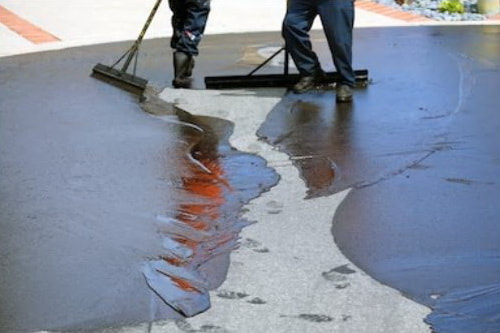Efficient Asphalt Repair: Cold Mix Sealing Techniques Introduced
Efficient Asphalt Repair: Cold Mix Sealing Techniques Introduced
Blog Article
Cold Mix Asphalt Vs. Hot Mix Asphalt: Which Is Right for You?

Make-up Distinctions
Cold mix and hot mix asphalts differ dramatically in their make-up, with distinct features that affect their performance and applications. Cold mix asphalt is produced by emulsifying the asphalt binder with water and an emulsifying agent before mixing it with aggregate. This technique enables the asphalt to be workable at reduced temperatures, making it optimal for short-term repair work and for usage in colder climate condition. Warm mix asphalt, on the various other hand, is produced at high temperature levels, usually in between 300-350 ° F, which assists to attain far better compaction and a much more sturdy end product. The warm mix asphalt manufacturing procedure includes heating the accumulation and asphalt binder individually before incorporating them at the asphalt plant.
Furthermore, cold mix asphalt tends to be much less thick and more versatile than hot mix asphalt. This adaptability makes it far better suited for locations with higher levels of activity, such as driveways or roadways with hefty web traffic. In comparison, hot mix asphalt is understood for its high sturdiness and resistance to rutting and cracking, making it a preferred selection for highways and high-traffic roadways where durability is important.
Setup Process Variances
The procedure of setting up chilly mix and hot mix asphalt displays notable variances in their procedures and needs. Cold mix asphalt, being a more adaptable product, can be used directly from the bag or container onto the split or damaged location. It needs very little preparation work, such as cleansing the area and compacting the cool combine with hand tools. This makes it a convenient option for temporary and fast solutions. In contrast, hot mix asphalt demands an extra elaborate setup procedure. It includes heating the blend to heats before laying it down on a properly prepared base. The prep work includes compacting the base, using a tack coat, and utilizing heavy equipment like pavers and compactors for a durable and smooth surface. Due to the heating needs, warm mix asphalt installations are normally brought out by specialists with customized devices, ensuring a more structurally audio and irreversible outcome.
Durability and Durability Aspects
When considering asphalt options, durability and longevity are important variables to examine for long-term sidewalk efficiency,. Warm mix asphalt (HMA) is understood for its remarkable longevity and long life. The heats throughout the blending and laying procedure enable better compaction, resulting in a denser and more powerful pavement More hints structure. This brings about HMA being a lot more immune to hefty web traffic tons, severe climate condition, and the results of aging contrasted to cool mix asphalt (CMA)
In regards to durability, HMA usually outperforms CMA as a result of its superior stamina and resistance properties. HMA pavements have a longer life span, needing less constant repair services and maintenance, which can translate to set you back financial savings over time. Additionally, HMA pavements are extra quickly personalized to meet particular task demands, additionally enhancing their longevity.
Price Factors To Consider
Thinking about the economic effects is an important aspect when reviewing the selection in between warm mix asphalt (HMA) and cold mix asphalt (CMA) for pavement jobs. While the initial expense of hot mix asphalt is normally greater than that of cold mix asphalt, HMA typically provides an extra cost-efficient option in the long run due to its remarkable longevity and longevity.
Along with material expenses, it's necessary to consider the costs related to installation and maintenance when contrasting HMA and CMA. HMA generally calls for customized tools and skilled labor for proper installment, which can impact overall project prices. Alternatively, CMA is less complicated to function with and can typically be applied utilizing less complex methods, possibly lowering installment expenditures. Ultimately, the read this decision between HMA and CMA must take right into account not just the first price yet likewise the long-term monetary effects to identify the most cost-efficient option for the certain sidewalk job.
Environmental Effect Contrast
Comparison of the ecological influences in between hot mix asphalt (HMA) and cool mix asphalt (CMA) discloses distinct distinctions in sustainability methods. HMA manufacturing needs high temperatures, leading to raised energy intake and greenhouse gas emissions.
Furthermore, the use of CMA often involves reusing existing asphalt pavement, advertising resource preservation and lowering the quantity of waste sent out to land fills. This reusing facet additionally boosts the sustainability of CMA compared to HMA. Overall, when thinking about the environmental impact, CMA becomes a much more ecologically sustainable option due to its lower energy needs, reduced discharges, and the potential for reusing existing materials. By going with CMA over HMA, road building and construction tasks can add favorably to ecological preservation efforts.
Conclusion
In verdict, the selection in between cool mix asphalt (CMA) and warm mix asphalt (HMA) depends upon numerous elements such as make-up, installment procedure, longevity, long life, expense, and ecological effect. cold mix asphalt. While CMA supplies a cost-effective and fast remedy for minor repair work, HMA makes certain remarkable resilience and durability for rush hour locations. Think about these aspects thoroughly to determine which sort of asphalt is the appropriate option for your paving needs

Thinking about the financial implications is an important element when examining the option in webpage between hot mix asphalt (HMA) and cold mix asphalt (CMA) for sidewalk jobs. While the first expense of warm mix asphalt is usually higher than that of cool mix asphalt, HMA often provides an extra cost-effective option in the long run due to its premium resilience and longevity. asphalt repair.Comparison of the environmental impacts between warm mix asphalt (HMA) and cold mix asphalt (CMA) exposes distinct distinctions in sustainability methods.In conclusion, the selection in between cool mix asphalt (CMA) and warm mix asphalt (HMA) depends on different aspects such as composition, setup process, toughness, longevity, expense, and ecological impact
Report this page